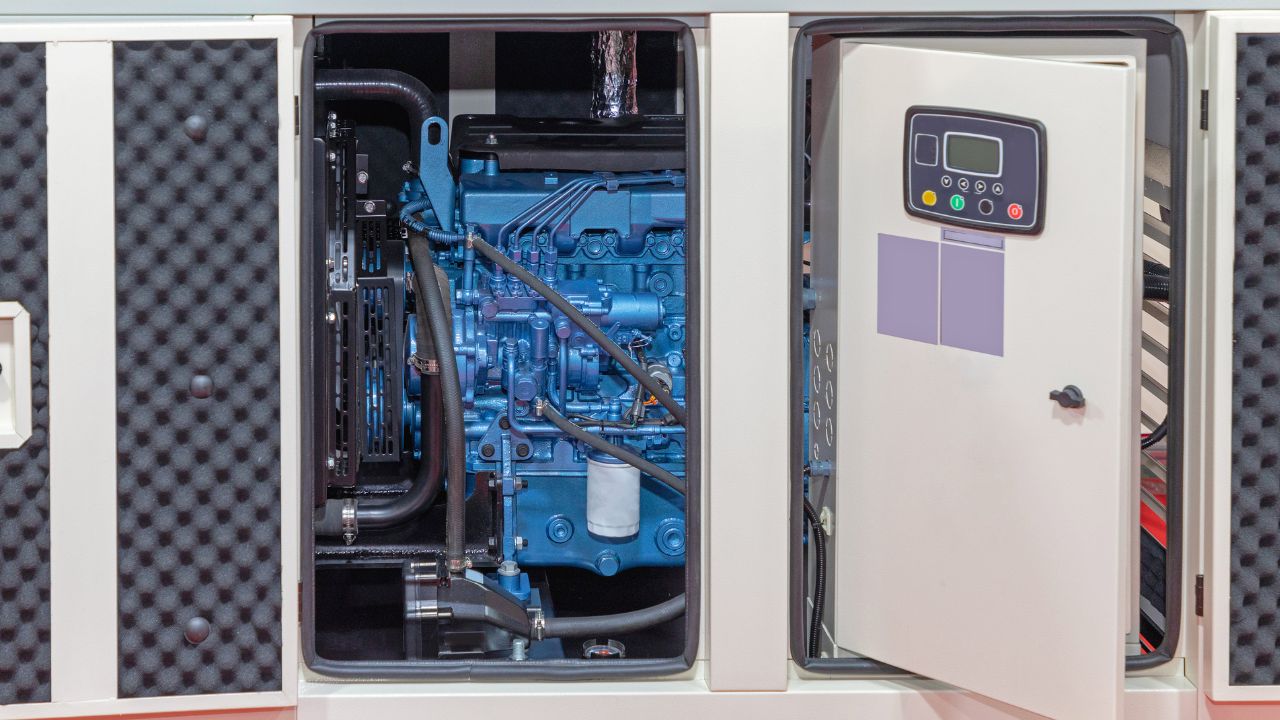If you have a generator that has been sitting for a while, it is important to know how to start it up correctly. Here are a few tips on how to get your generator running again:
-First, check the oil level and add more if needed.
-Then, check the fuel supply and make sure there is enough gas in the tank. If not, add more gas. -Next, consult the owner’s manual for specific instructions on starting your particular model of generator.
-Once you have followed all of the necessary steps, try starting the generator. If it still won’t start, double-check all of your connections and settings before calling a professional for help.
- Open the generator’s gas valve by turning it counterclockwise
- Prime the generator by pouring a small amount of gasoline into the carburetor
- Pull the starter cord to start the engine
- The engine should start within a few seconds
- Adjust the choke if necessary to keep the engine running smoothly
- 9500 Running Watts and 12500 Peak Watts (Gasoline); 8500 Running Watts,...
- Features Two GFCI 120V 5–20R Standard Household Receptacle, One Transfer...
- Powered by a Heavy Duty 457cc Westinghouse 4-Stroke OHV Engine Featuring a...
- Plug-and-Play: Comes With a Remote Start Key Fob, 12V Battery Charger, Oil,...
- EFFICIENT CHARGING: Use the adapter included in the package to charge the...
- COMPACT & PORTABLE DESIGN: Super slim size(6.5 x 4.6 x 3.1 inches), the...
- MULTI-OUTPUT: There are 8 output ports could be used at the same time, and...
- BRIGHT LIGHTS: With three levels of brightness, the portable power bank can...
- Keep your family safe with 5600 starting watts and 4500 running watts of...
- Electric start functionality turns the 224cc engine on with the press of a...
- The WEN Watchdog CO Shutdown Sensor helps protect both you and your family...
- 4.3-gallon gas tank provide up to 12.5 hours of half-load run time
- Perfect as a backup power source for larger homes or a dependable source of...
- 14,500 peak watts, 11,500 running watts (gasoline); 13,500 peak watts,...
- Runs for up to 19 hours on a 9.5 gal. fuel tank with built-in fuel gauge;...
- Powered by a heavy duty 550cc 4-Stroke OHV Westinghouse Engine constructed...
- At less than 49 pounds, this inverter is one of the lightest 4000-watt...
- 64 dBA from 23 feet is perfect for camping, tailgating or to backup a few...
- The optional parallel kit enables this inverter to connect with another...
- Includes a 120V 25A TT-30R outlet, a 120V 20 A household duplex outlet...
how to START a generator that’s been “sitting too long”
How Long Can a Generator Sit Without Use?
If you’re planning on keeping a generator around for occasional power outages or other emergencies, you might be wondering how long it can sit without use. The answer varies depending on the type of generator and how it’s maintained, but in general, most generators can go several months between uses without any issues.
For example, portable generators should be drained of fuel and oil before being stored for more than two weeks.
This will help prevent stale fuel from gumming up the engine. You should also run the engine for a few minutes every month to keep everything lubricated and in working order.
Standby generators, which are larger units that are permanently installed and typically used to power essential systems in a home or business, can go much longer without use.
However, they still need to be regularly maintained according to the manufacturer’s instructions. This usually means running a self-test once a week and scheduling an annual maintenance checkup with a qualified technician.
How Do You Start a Generator That Won’T Start?
If your generator won’t start, there are a few things you can do to try and get it going. First, check the fuel level and make sure there is enough gas in the tank. If the tank is empty, fill it up and try again.
Next, check the oil level and make sure it is full. If it isn’t, add more oil and try starting the generator again. Finally, if all else fails, call a professional to come to take a look at it.
How Do You Reactivate a Generator?
If your generator has been sitting for a while, it’s important to know how to reactivate it before you need to use it. Here are the steps you need to take:
1. Fill the generator with fresh fuel. If the fuel is old, it may not burn properly and could damage the engine.
2. Change the oil and oil filter. This will help ensure that the engine is lubricated and running smoothly.
3. Check all of the fluids in the generator, including the coolant level and battery acid level. These should be at the proper levels before starting the generator.
4. Inspect all of the hoses and belts on the generator to make sure they are in good condition and not cracked or frayed.
5. Once you’ve done all of these things, you should be able to start your generator without any problems!
Will a Generator Start With Old Gas?
The answer is maybe. If your generator has a carburetor, the gas in the tank may have evaporated and left behind a sticky residue that can prevent the engine from starting. Additionally, if you’ve stored your generator for an extended period, the seals in the fuel system may have dried out and begun to leak, allowing air to enter the system.
This can also prevent your generator from starting. To be safe, it’s always best to use fresh gas when operating your generator.
How to Start a Generator With a Key
Assuming you’re talking about a portable generator: Portable generators are useful in several different situations, from camping to power outages. But how do you start a generator with a key?
Here’s a step-by-step guide:
1. Make sure the generator is properly fueled – this usually means gasoline for smaller generators and propane for larger ones.
2. Check the oil level and add oil if necessary – most generators have an oil dipstick that you can check just like on a car. Add oil if it’s low.
3. Connect the generator to whatever you need it to power – this could be an extension cord to your home’s circuit breaker box, or it could be directly connected to appliances via special outlets. Be sure to follow the manufacturer’s instructions on how to properly connect the generator.
4. Open the fuel valve – again, consult your owner’s manual for specifics on where this is located on your model of generator. This step is critical, as failing to open the fuel valve will prevent the engine from starting even if everything else is in order.
5. Start the engine – typically, there will be a switch near the fuel valve that says “on” or “start.” Flip this switch and then pull on the starter cord (usually located next to the switch) until the engine starts up.
How to Start a Generator Manually
If you find yourself in a situation where you need to start a generator manually, don’t worry! It’s not that difficult. Here are the steps you’ll need to follow:
1. Locate the generator. Usually, generators are located near the main electrical panel.
2. Once you’ve found the generator, open up the access panel so that you can see the control panel inside.
3. On the control panel, locate the “start” button or switch. In some cases, there may be a key required to turn on the generator – if this is the case, insert and turn the key as needed.
4. Once the generator is turned on, it should begin providing power to your home automatically.
How to Start a Diesel Generator That Has Been Sitting
If you have a diesel generator that has been sitting for a while, there are a few things you need to do before starting it up. First, check the oil level and make sure it is topped off. Next, check all of the fluids and make sure they are at the proper levels.
Finally, inspect the belts and hoses to make sure they are in good condition. Once you have done all of this, you can start the generator by following these steps:
1) Open the fuel shut-off valve
2) Prime the fuel system by depressurizing it or manually pumping fuel into the injectors
3) Turn on the ignition switch
The generator Won’t Start
If your generator won’t start, there are a few things you can check to try and troubleshoot the issue. First, make sure that there is enough fuel in the tank. If the tank is empty, fill it up and try starting the generator again.
Next, check the oil level and make sure it is full. If it isn’t, add more oil and try starting the generator again. Finally, if neither of these solutions works, you may need to call a professional to help you diagnose and fix the problem.
How to Start a Generator Without a Key
If you need to start a generator without a key, there are a few different ways that you can do it. One way is to use a screwdriver to turn the flywheel. Another way is to use a drill to spin the flywheel.
Keep in mind that starting a generator without a key can be dangerous, so it’s important to be careful and follow all safety instructions.
How to Start a Generator With a Choke
When you need to start a generator, the first thing you’ll need to do is find the choke. The choke is usually located near the air filter on the side of the engine. Once you’ve located it, pull out the knob and turn it to the “choke” position.
Next, open up the fuel valve and make sure that there’s gas in the tank. If there isn’t, then fill it up before proceeding. Once you’ve confirmed that there’s fuel in the tank, go ahead and pull the starter cord.
The engine should start right up. If it doesn’t start right away, don’t worry – just keep trying. It may take a few tries before it finally catches.
Once it does start, let it run for a minute or two before slowly moving the choke back to the “off” position. And that’s all there is to start a generator with a choke! Just remember to be patient when pulling the starter cord – eventually, it will catch and you’ll be able to power up whatever you need!
Starting a Generator With Old Gas
If you’re like most people, you probably don’t think much about your generator until the power goes out. But if you want to be prepared for an emergency, it’s important to know how to start a generator with old gas. Here’s what you need to know:
1. Drain the old gas from the tank. This is necessary because gas can go bad over time and will damage your engine.
2. Add fresh gas to the tank. Make sure to use a fuel stabilizer if you’re not going to use the generator right away. This will help keep the gas fresh and prevent it from going bad.
3. Check the oil level and add more if necessary. Old oil can also damage your engine, so it’s important to make sure it’s at the proper level before starting the generator.
4. Finally, start the generator and let it run for a few minutes before turning on any appliances or lights that you need to be powered up. This will allow the engine to warm up and prevent any potential damage from starting cold.
How to Start a Generator for the First Time
If you’ve never started a generator before, the process can seem a bit daunting. But don’t worry – we’ll walk you through everything you need to know to get your generator up and running for the first time.
First, make sure you have all the necessary supplies on hand.
You’ll need fuel (either gasoline or propane), oil, and a way to start the generator (usually a battery). Once you have everything gathered, it’s time to get started.
To start, open the fuel valve and prime the engine by depressing the primer button several times.
Next, move the switch to the “On” position and pull the starter cord until the engine starts. Once it’s running, move the choke lever to the “Run” position.
Now that your generator is running, there are a few things you need to do to keep it operating safely and efficiently.
First, check the oil level and add more if needed. It’s also important to monitor the exhaust temperature – if it gets too hot, shut down the generator immediately and let it cool off before restarting.
Following these simple steps will help ensure that your generator runs smoothly and safely for years to come.
Conclusion
If you have a generator that has been sitting for a while, it’s important to take the proper steps to start it up again. First, check the oil level and make sure it is topped off. Next, clean any debris from the air filter.
Then, fill the gas tank and add a fresh fuel stabilizer. Finally, start the generator and let it run for a while before using it. By taking these steps, you can ensure that your generator will be ready to use when you need it.





